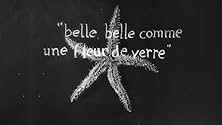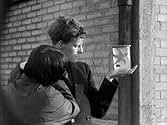L'étoile de mer
- 1928
- 21 Min.
Füge eine Handlung in deiner Sprache hinzuTwo people stand on a road, out of focus. Seen distorted through a glass, they retire upstairs to a bedroom where she undresses. He says, "Adieu." Images: the beautiful girl, a starfish in a... Alles lesenTwo people stand on a road, out of focus. Seen distorted through a glass, they retire upstairs to a bedroom where she undresses. He says, "Adieu." Images: the beautiful girl, a starfish in a jar, city scenes, newspapers, tugboats. More images: starfish, the girl. "How beautiful s... Alles lesenTwo people stand on a road, out of focus. Seen distorted through a glass, they retire upstairs to a bedroom where she undresses. He says, "Adieu." Images: the beautiful girl, a starfish in a jar, city scenes, newspapers, tugboats. More images: starfish, the girl. "How beautiful she is." Repeatedly. He advances up the stair, knife in hand, starfish on the step. Three p... Alles lesen
- Regie
- Drehbuch
- Hauptbesetzung
- Une femme
- (as Alice 'Kiki' Prin)
Empfohlene Bewertungen
This is another of those many films that not only asks for multiple viewings, it requires it. Every time you view it again, you see something or something else fits in so that it becomes an even larger work.
Don't worry, though... this isn't one of those hard-to-watch films that don't make any sense and you have to stick with it just to "get it." On the contrary, it's a relaxing and pleasantly visual film that works more as a treat for the eye than a lengthy condescending piece of symbolism. It's based on a poem by the great Robert Desnos, and is very poetic in that quietly beautiful way. If anything, the best part of this film is how Ray's mise-en-scene always directs the eye simply to the right part of the screen, so that almost no work is done by the spectator to just sit back and experience it. On the other hand don't go into this film if you're really tired.
--PolarisDiB
The cinematography is by far the best part of the short, and feels very ahead of its time. The camerawork is extremely experimental, and there's a lot of long, lingering shots. The film also uses framing to its advantage and you can tell a lot of effort went into it. Also in terms of visuals, I really enjoyed the text that appears on screen.
The sound design is done fairly well and is effective in some places, but I don't like the score. The score feels way too repetitive and gets old after the first couple of minutes. However, the sound design immediately helps to create an eerie atmosphere.
I don't feel like I can comment on the acting, as the characters are barely shown and aren't the main focus of the short film. The character development is near nonexistent and they have nothing special or notable about them to discuss.
Lastly, the film has an interesting tone, but the pacing lets it down. It's a very unnerving movie and has a strong experimental and arthouse vibe, with an unnatural structure to go alongside. Unfortunately, I ended up getting quite bored while watching and I feel the short would've benefit from having a shorter run time.
"L'Étoile de merde" ... whoops, "de mer" ... features a lot of blurry photography and a recurring visual theme of a starfish, which is never explained. Starfishes have the fascinating ability to regenerate lost limbs -- and even to regenerate entire duplicate bodies -- but, if that has anything to do with this movie's theme, Ray neglects to say so. I was much more impressed by this movie's title cards, which (in French) manage to include rhymes, a pun ('Si belle, Cybele') and some portmanteaux.
As so often in Ray's work, there is indeed a beautiful young woman seen in this movie. Unfortunately, the photography is (largely) so blurred that we have little opportunity to appreciate her. I'll rate this mess one point out of 10.
What we see in the first moments is a man and woman walking together, going up to a room, and we can make out a woman disrobing (maybe not all the way, but close to it), and the man leaves her in bed. Then a flow of images come forward - not quick at all, but in the wave that comes with a hallucination under a psychedelic or in that weird wave right before you go to sleep, if not outright dreams: a starfish, close-up, in slow-motion; twelve different shots of starfish and starfishes in glasses (four across, three up); and the woman in bed or the man walking alone.
What does all this mean? Should it matter to decipher it? At the time this film was one of many in the wave of surrealists coming forward - it was either this or another of Ray's films that screened with Bunuel's debut Un chien Andalou in 1929 - and in here, there's nothing THAT scandalous about it for today. It might have been for the period though: just the thought of a woman disrobing, or just showing her legs, as she does, albeit out of focus (and we can see when the camera goes in focus part of her leg and foot) was unthinkable for a prudish, mass collective audience. And if Man Ray was Catholic, as several of the surrealists and dadaists like Dali and Bunuel were, that was part of the point, to provoke himself as much as the audience around him with these startling images. There may also be violence invoked here as well, with a woman stalking up stairs with a knife.
Some inter-titles come up from time to time here, and the most intriguing and poetic come at the start: "Women's teeth are objects so charming... that one ought to see them only in a dream or in the instant of love." Could this be a clue as to what the film is "about" if anything? Or is it all part of the piece itself, leading a viewer through a stream of images and contrasts - think the soft flesh of a woman's skin with the scaly outside of a starfish itself - and about what a woman's presence means in general? Teeth being invoked is also curious and unsettling - why only in love or a dream? Perhaps for Man Ray, teeth are what the eyeball was to Bunuel.
Or, again, as in a dream, everything means something else to that person. Starfish isn't as direct or confrontational as Bunuel & Dali's dreamscapes, but it does what it should by bringing the audience along through images that, at that time and rarely since, no one has seen quite like before. Visualizing such an inner-sanctum as the subconscious is one of those things cinema does well, and Man Ray shows it.
It is a typical example of experimental cinema from this era, which also unleashed the likes of Germaine Dulac's THE SEASHELL AND THE CLERGYMAN (1928; the main reason I picked up this Kino DVD collection in the first place!) – with a similar aquatic reference, no less! – and the Luis Buñuel/Salvador Dali collaboration UN CHIEN ANDALOU (1929), both of which also boasted overtones of eroticism and violence. Even so, the most notable effect here is the frequent distortion of the image, as if it was being shot through stained-glass windows!
Wusstest du schon
- VerbindungenFeatured in Un siècle d'écrivains: Robert Desnos (1997)
Top-Auswahl
Details
- Laufzeit
- 21 Min.
- Farbe
- Sound-Mix
- Seitenverhältnis
- 1.33 : 1














